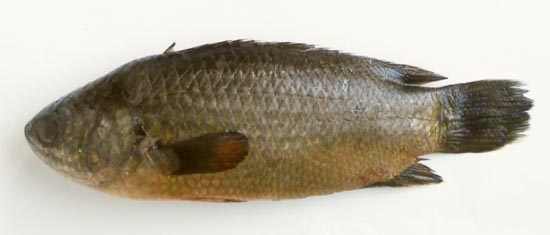
Synonyms:
Anthias testudineus: Bloch, 1795.
Anabas scandens: Day, 1878; Day, 1889.
Anabas testudineus riveri: Das, 1964.
Anabas testudineus ricei: Das, 1964.
Anabas testudineus locustri: Das, 1964.
Anabas testudineus: Bhuiyan, 1964; Munro, 1955; Sterba, 1962; Thakur and Das, 1968; Shaw and Shebbeare, 1937.
Cojus cobojius: Hamilton, 1822.
Common name: Climbing perch (English name).
Bangla name : Koi.
Taxonomic position:
Phylum: Chordata
Class: Osteichthyes
Order: Perciformes
Family: Anabantidae
Genus: Anabas
Species: A. testudineus
Morphological description:
Body laterally compressed. Mouth is anterior and lower jaw slightly longer. Villiform teeth are present on jaw. Long dorsal and anal fin is found. Body colour is dark to pale greenish, fading to pale yellow on belly where as dorsal and caudal fin dark grey, anal and pectoral fins pale yellow, pelvic fin pale orange colour. Pectorals and caudal fin rounded. Dorsal, pelvic and anal fin rays are modified to spin. Scales are ctenoid, lateral line interrupted (Rahman, 2005; Talwar and Jhingran (2001) and Yadav(1997).
Fin formula:
D. XVI-XVIII/8-9, P1. 1/13-16, P2. I/5, A. IX-XI/10-11.
D. 17-18 /8-10, P1. 15, P2. 1/5, A. 9-10/9-11 (Bhuiyan, 1982).
D. XVI-XIX/7-10, P1. 15, P2. I/5, A. IX-XI/8-11 (Shafi and Quddus, 1982).
D. XVII-XVIII/8-9, P1. 15-17, P2. I/5, A. X-XI/9-10 (Rahman, 2005).
D. XVI-XVIII 8-10, P1. I 13-14, P2. I 5, A. XVIII-IX 10-11 (Talwar and Jhingran, 2001).
Scales are recorded below lateral line is 9 to 11 and up to 1st lateral line is 15 to 16 and up to 2nd lateral line is respectively 10 to 12. Scales number mentioned by Rahman (2005) is 1st lateral line continues up to 16-17 scales, 2nd lateral line continues up to 11-12 scales, above lateral line 4 scales and below lateral line 9 scales.
Habits and habitat:
Inhabits fresh and brackish water; mostly in canals, lakes, ponds, ditches, floodplains, haors, baors and swamps (Talwar, 2001), bottom dweller and insectivorous fish.
Breeding time:
Breeding starts in the month of April with the onset of monsoon and continues till July. Eggs are pelagic, floating over surface. At a temperature of 28.5°C hatching takes place in 18 hours (Rahman, 2005).
Economic importance:
This is a very hardy fish and is of considerable fisheries interest. It is regarded as a highly esteemed food fish for its fine flavour, restorative values and prolonged freshness out of water. The fish is suitable for cultivation in ponds, reservoirs and rice fields (Talwar, 2001). The species is an important and staple food fish over the whole country. Its importance to man arises from the inherent edible quality of its flesh (Rahman, 2005).
Ecological role:
Its food may include 10% algae, 17% higher plants, 23% protozoa, 3% worms, 30% crustaceans, 15% insect, 2% mud and sand (Mookerjee, et. al. 1946). So this fish is bottom dweller and plays an important ecological role.
Marketing status:
The species got a tremendous market demand. Market price is generally between 95-150 Tk/kg.
References:
Bhuiyan, A.L. 1964. Fishes of Dacca. Asiatic Soc. Pakistan, Publ. No. 13, Dacca. p. 109.
Bloch, M.E. and Schneider, J.G. 1795. Naturages ausland Fische, Systema Ichthyologiae. 6: p. 121.
Das, S.R. 1964. Ichthyologica. J. Roy. Asiat. Soc. Beng. Sci. 3(1/2): p. 93.
Day, F. 1878. Fishes of India. William Dowson and sons., London. p. 370.
Day, F. 1889. Fishes. Fauna. Brit. India. William Dowson and sons., London. II: p. 366.
Hamilton, F. 1822. Fishes of the Ganges. Archibald constable and company, Edinburgh. p. 98.
Mookerjee, H.K.; Sengupta, S.N. and Roy Chowdhury, D.N. 1946. Food and its percentage composition of the common adult food fishes of Bengal. Sci. and cult. Calcutta. 12(7): p. 247.
Munro, I.S. 1955. Marine and Freshwater Fishes of Ceylon. Dept. External Affairs, Canbarra Publications. p. 226.
Rahman, A.K.A. 2005. Freshwater Fishes of Bangladesh. The Zoological Society of Bangladesh, Dhaka. pp. 284-286.
Shafi, M. and Quddus, M.M.A. 2001. Bangladesher Matshaw Sampad (Fisheries of Bangladesh). Bangla academy, Dhaka. pp. 300-301.
Shaw, G.E. and Shebbeare, E.O. 1937. Fishes of Northern Bengal. J. Royal Asiat. Soc. Bengal Science. p. 112.
Sterba, G. 1962. Freshwater Fishes of the World. Vista Books, London. p. 781.
Talwar, P.K. and Jhingran, A.G. 2001. Inland Fishes of India and Adjacent Countries. Oxford and IBH Publishing Co. Pvt. Ltd. New Delhi. 2: pp. 996-998.
Thakur and Das, 1968. Bull. Cent. Inland Fish. Res. Inst., (40): pp. 1-47.
Yadav, B.N. 1997. Fish and Fisheries. Daya Publishing House, Calcutta. p. 319.
Visited 23,095 times, 1 visits today | Have any fisheries relevant question?
